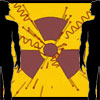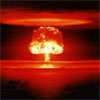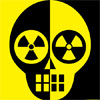Atomic Radiation And Its Effects On Living Tissue ~ Part III
 by Jack Schubert, Ph.D. And Ralph E. Lapp, Ph.D.
by Jack Schubert, Ph.D. And Ralph E. Lapp, Ph.D.
Skin. All external radiation incident upon the body must first pass through the skin. Skin consists of two layers—the outer epidermis and an inner dermis. The epidermis consists of several layers of cells and on the average is about .003 inch thick. In the dermis are located the nerve endings, blood supply, glands, and fat.
A noticeable effect of radiation on the skin is the production of a reddening—erythema—which results partly from an enlargement of the small blood vessels supplying the skin. The development of an erythema is often used to gauge the amount of radiation delivered during x-ray or radium treatment. A distressing feature of the early stages of skin damage by radiation is the so-called radiodermatitus characterized by intense and incessant itching around an ulcerated area.
Cancer of the skin produced by radiation was first described in 1902. The patient was a worker in a factory making x-ray tubes. Since then thousands of cases of skin cancer have been produced by overdoses of radiation. The latent periods are long, averaging about 30 years before the cancer appears. In all such cases the skin showed typical radiation changes and cancer developed later. The precancerous lesions are often minor and skin in the immediate vicinity looks normal. Most of these skin cancers, however, were produced by thousands of r of radiation. Doses up to 1500 r or more may not produce signs of serious damage very soon after irradiation, but late follow-up studies often will show evidence of minor to severe damage. Larger doses of about 4000 r are soon followed by obvious skin damage—for example, the skin becomes thinner, and the surface is usually covered with dilated blood vessels. The skin in these cases is very sensitive and prone to infection. It is in such skin especially that cancer is most liable to develop.
Dr. H. L. Trainkle of Buffalo, New York, studied 935 cases of skin cancer treated during 1946-1953 with 4000 to 5000 r. Some 55 cases of radiation necrosis (death or mortification of tissue) were observed, with a latent period of from 4 months to 6 years. He stated, “It appears that even when conservative roentgen therapy is administered for skin cancer, some degree of late inflammation and necrosis in the irradiated field ultimately develops in a disturbingly high percentage of cases.”
When low doses of radiation to the skin occur over a period of years an insidious form of injury ensues. In the past dentists who for many years held photographic film in their patients’ mouths while taking x-rays of the teeth incurred serious damage to the skin of fingers which in many cases developed into cancer. Small protracted exposures of the skin caused no reddening. The first sign may be changes in the appearance of the fingerprints, loss of hair, splitting of the nails, and dryness of the skin. Later changes include the appearance of strawberry marks, pigmentation, wasting away of skin, and wart-like growths. Minor cuts and bruises may not heal readily.
The effect of beta rays on the skin has been studied very carefully, with the use of radioactive isotopes. The beta particles from phosphorus-32 are very energetic. This and the ease of working with the material makes the study of its effects on the skin comparatively simple. The late Dr. B.V.A. Low-Beer, of the University of California Medical School, dipped blotting-paper disks into water solution containing phosphorus-32. After he had dried the disks, they were applied over normal healthy skin on parts of the arms and forearms of twelve subjects. The blotting-paper disks were left on for different periods of time, to vary the radiation dosage. It was found that about 150 rad produced a reddening of the skin three to five days after exposure. This increased in intensity up to the fourteenth or sixteenth day and then subsided within a month. Two months later a very slight pigmentation was noted. With higher doses a more intensive reddening occurred, starting about the third day, but again recovery took place, except for pigmentation, within two months.
The hair follicles and glands of the skin are also affected by radiation. Exposure to from 300 r to 400 r causes temporary, and higher doses cause permanent, loss of hair. The amount of dosage causing temporary loss of hair often damages the pigment-forming cells as well, so that the hair which grows back may be gray. In heavily irradiated skin, destruction of the sweat glands causes the skin to lose permanently the ability to sweat. With doses of about 1500 r the skin also loses it normal greasy texture because of destruction of the oil-producing glands.
Eye. Radiation cataracts are among the best-known effects on the eye. The term “cataract” implies the presence of opacity or turbidity in the normally transparent lens, varying from a tiny granule which may disappear, to large spots resulting in blindness. Cataracts are more readily produced by neutrons than by x-rays. The lens of the eye is a practically non-growing tissue, and so it was considered surprising to find it relatively responsive to radiation. This brings up an interesting point, namely that an amount of damage noticeable in the eye might go unnoticed in other tissue, and the tissue might therefore be thought to be resistant to radiation. Dr. A.M. Brues of the AEC’s Argonne National Laboratory put this neatly at the Geneva Conference when he stated, “The lens, being a transparent organ, is a particularly sensitive indicator of a type of change that might easily escape notice elsewhere.”
Bone and Teeth. Adult bone and cartilage, excluding the bone marrow, appear resistant to early radiation effects. Bone cancer has often appeared years after exposure to heavy doses of radiation (1500 r and more). Radiation of the bones of children has caused retardation of growth. About 150 r of radiation delivered to the bones of infants has disturbed growth, and heavier doses have resulted in limb shortening. Local irradiation of the jaws has slowed tooth growth.
Larger doses of radiation, many times larger than the doses used by the dentist for making x-ray pictures of the teeth, may be followed by infection about the teeth, resulting in loss of the teeth and destruction of the jawbone. An important point, well known to radiologists, is that a patient who is about to be given heavy radiation treatment over the jaws should first have all teeth removed which do not look good. Extraction of teeth, even years after heavy irradiations, may be followed by widespread necrosis. In the well-known textbook on cancer treatment by Dr. Max Cutler, it is flatly stated that “the simple extraction of a tooth following extensive irradiation [in the jaw region] has been the cause of death in a considerable number of patients.”
The best-known cases of bone damage and cancer are those resulting from the deposition in the bones of radioactive isotopes such as radium, plutonium, and strontium. Very small amounts of these radioactive isotopes eventually cause widespread destruction of bone, which culminates in bone cancer in many instances. As little as 0.06 microcuries of radium has caused the appearance, decades later, of lesions visible in an x-ray film.
Brain. The brain is considered to be relatively insensitive to small radiation doses, but this does not mean that there is no damage—it means rather that there exists no suitable means of detecting damage, or that it has not been looked for, or that no cases have been followed for a long enough time. One must be suspicious of all tissues to which radiation has been given.
Relatively small doses of radiation to localized regions of the brain give immediate effects. In 1953 two volunteers were given 100 r to a localized region of the brain (diencephalon). About one and one-half hours later they complained of ringing in the ears, generalized numbness, and apathy. Shortly thereafter they felt psychically stimulated. Sleep that night was very deep. The next morning they were very active and “high”. Then they became unusually quiet. The disturbances lasted about seven to ten days. These effects were confirmed in another experiment involving 120 persons.
Single doses of the order of 500 r and more have produced brain damage in children. In the Japanese atomic-bomb casualties, the most severe effects were found in the youngest patients.
There have been several reports of brain damage in persons given heavy doses of radiation for brain tumors or for lesions of the scalp. A description of some typical cases has been included in a review by Dr. Webb Haymaker of the Armed Forces Institute of Pathology which appeared in a 1956 National Research Council report. In most of these, confirmation of radiation damage was made by direct examination of the brain.
“A traveling salesman aged 34. . .became ill 4 ½ to 5 years after receiving x-radiation for a scalp condition. Blindness, paraplegia, and epileptic attacks developed. A radiation ulcer formed in the [eye] region. Death occurred 2 years after the onset of neurological disturbances.
“[Here is]. . .a case of brain damage in a 5-year-old girl following x-irradiation of a scalp lesion. Complete epilation occurred in 3 weeks. One year later, epileptic attacks and [paralysis on the left side] developed. At 12 years [of age] the left side of her body was underdeveloped. Minor epileptic seizures were common.
“. . .a 20-year-old woman, had been given radiation therapy for a scalp lesion when she was 9 years old. At 15 she became nervous and emotional. Later she had an episode of delirium associated with fever. At the hospital she was found to have [mild paralysis on the right side]. . .deviation of her eyes to the left, and. . .twitchings of the right arm and face. At 21 she was readmitted to hospital because of increased frequency of epileptic attacks. Little hair remained on the scalp.”
Lung. Immediate radiation effects on the lung—i.e., effects occurring within a few months—seem to result only from very heavy doses of radiation, such as those received incidental to treatment of breast cancer. After doses in the range of 2000 to 3000 r, the lung tissue may swell and show scarring and other effects. Radiation to animals delivered over long periods of time has produced lung tumors. The constant breathing of radioactive radon by uranium miners has produced, or at least contributed to the production, numerous lung cancers after an average period of seventeen years. The radiation dose comes principally from the non-volatile daughters of radon which become attached to dust particles and are retained in lungs.
Is it possible to treat radiation injury? Just as with the common cold, it can be said that “the list of remedies is noteworthy more for its length than for any usefulness.” This is the still valid conclusion reached in 1949 by W.A. Selle of the University of Texas in a survey where he reviewed the available information concerning attempts to prevent or reduce radiation injury by use of drugs. He goes on to say:
“With few exceptions, all agents reported to influence favorably the course of mild to severe radiation sickness must be given prior to exposure. They are ineffectual if given after irradiation, and therefore offer little or no protective value to large, accidental, and designed radiation exposures of peacetime or to unexpected exposures in wartime.”
However, much study and experimentation in hospitals and laboratories throughout the world is going on. Some important leads have been found, and some helpful measures uncovered. While a specific cure for radiation injury is not known at present, much can be done by what are technically called supportive or symptomatic measures to make those receiving lethal doses more comfortable and to save the lives of individuals who may receive 400 r or less whole-body radiation. The recommended measures include:
1. bed rest and sedatives;
2. maintenance of fluid and mineral balance;
3. if infection develops, the administration of broad-spectrum antibiotics in large doses;
4. anti-shock drugs;
5. anti-hemorrhagic drugs to control bleeding;
6. blood transfusions, if indicated by clinical and laboratory tests.
In many cases patients may be unable to take food by mouth, particularly when the digestive tract is inflamed, so intravenous feeding may be necessary, along with vitamins. It is felt that the administration of drugs, without a clear indication of their worth, should be kept to a minimum because of their unknown and possible harmful effects on the irradiated individual whose metabolism is already deranged.
While all these measures may prolong life and make it more comfortable, they do not seem to affect the fundamental disturbances produced by radiation. In animals, at least, treatments have prolonged life but they have not saved it or prevented the late effects from eventually developing. Practically no work has been done on finding a treatment for radiation injury of the long-delayed type which comes months or years after radiation exposure.
The considered opinion of the experts in 1956 regarding drugs for treatment of radiation injury has been summarized by the Committee on Pathological Effects of Atomic Radiation as follows:
“At present there are no specific prophylactic [preventive] or therapeutic agents that should be stock-piled for use in the hematological [blood-cell] depression and the resulting disease state following exposure to total body irradiation.”
However, with varying degrees of success, the search for drugs to treat radiation injuries continues feverishly. Protection against radiation injury consists in either preventing the radiation from reaching the body or counteracting the effects afterward. One test of a drug is to ascertain whether its administration before a killing dose is given to a group of animals results in increased survival. Such drugs usually act by reducing the amount of noxious radiation-produced activation products of water. Drugs which have been found effective in this respect are the so-called sulfhydryl compounds, which, when present in high enough concentrations, bear the brunt of the attack by the activated water fragments and thus protect sensitive cellular substances which would otherwise be destroyed. The first successful protection of animals by such compounds was reported by Dr. H.M. Patt of the AEC’s Argonne National Laboratory in 1949. Other drugs protect a little more indirectly by removing from the cell oxygen needed for the optimum production of the activated water fragments. However, all these drugs have to be given before irradiation.
Since the primary chemical act of radiation on the tissues is instantaneous, it does not appear possible to find therapy that would protect the animal after radiation exposure. However, there are agents which promote recovery and in this way increase survival even when given after radiation exposure. The fundamental and very exciting discovery in this field was made by Dr. L.O. Jacobson of the University of Chicago in 1951. In earlier work Dr. Jacobson found that mice whose spleens were shielded while they received whole-body irradiation were able to tolerate twice as much radiation. This led to the injection into animals extracts of the spleen and bone marrow which seems to aid recovery by promoting the regeneration of blood cells.
Whether the protective actions of the spleen and bone-marrow preparations involve a chemical substance or a “seeding” with cells around which new cells develop is a provocative question. The answer to this problem is one which may eventually result in the development of an effective therapy.
Excerpt from Radiation: What It Is And How It Affects You
Posted in Health, Other Topicswith comments disabled.





